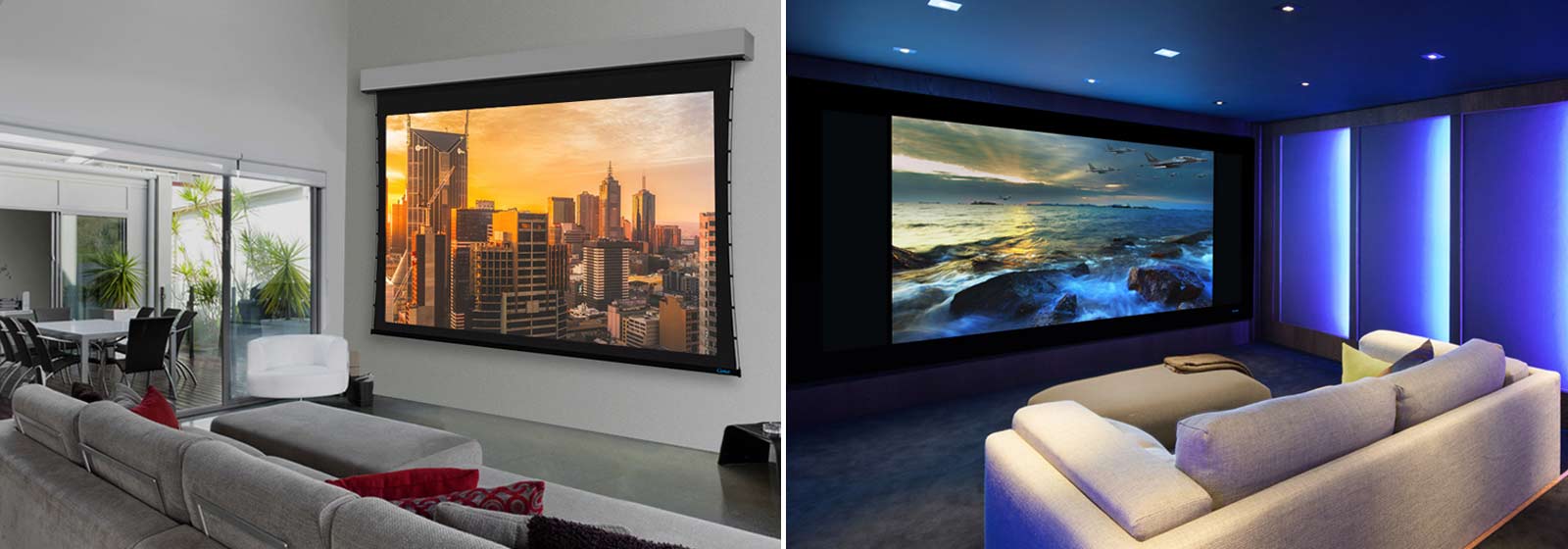Choosing a screen for your home cinema
If you're thinking about upsizing your screen to cinema proportions then a filmscreen is what you need. Nothing beats sitting back and enjoying the big screen experience in your own home. Making the best choice for your screen requires a little groundwork first though. Here are a few things to think about when looking for a cinema screen.
Image resolution
To get the maximum resolution from your projection source, the screen must be absolutely flat and have no texture. When an image hits a textured screen, it results in noise and distortion. Ideally, the texture of the screen surface should be smaller than the pixel size of the image and having a smooth surfaced screen is becoming more important as we move into 4K and 8K projection. So no, a painted wall, or bedsheet won't work. The image will be distorted, noisy and show imperfections in the surface, and colours will also be distorted.

Reflectivity and brightness
A painted wall doesn't reflect light in an even way and will result in a dim and washed out looking image. Filmscreens offer much better reflectivity and can actually offer different gain levels to suit different room, projector and screen size requirements. The reflectance of a screen is measured by this gain value, and you might notice these listed on a screen or material. A gain value of 1 means all of the light is reflected from the screen, which means a brighter image, but performance may drop as the image is viewed more from the side. In other words, a smaller room with a more spread out audience calls for a screen with less reflectance, so that all of the viewers can see the image clearly.
What this means in practice is that bigger and brighter isn’t necessarily better. A screen that’s too big for the room will have viewers straining to see the whole picture (think front row of the movie theatre), or the projector not having enough brightness to adequately fill the screen.
Some adjustment can also be had through the colour of the screen. While normally white, screens can also come in shades of grey that affect the image depending on ambient light and projector power.
A screen with a lower gain can be a good choice for projectors that don't render black as well, or if you have a darker room. It’s important to make a detailed assessment of the lighting conditions in your room at the outset to determine how much ambient light is present, and what the requirements for your projector and screen will be.
Material
When deciding on the size of your cinema screen, you’ll need to take into account variables like the viewing distance, your projector, ambient lighting and room size. Once you've established the size though, it's important to select the right material. As mentioned above, the gain of a screen will have a big impact, and so too will the material used.
Material choice is fundamentally a tradeoff between gain and viewing angle - as gain increases, viewing angle decreases. Somewhere along this continuum lies your ideal material, and just to complicate things further there are materials offering other benefits like the elimination of the effects of nearby lights or sunlight.
An interesting exception to the recommendation of a perfectly flat screen are perforated screens. These have tiny holes through the material, making it acoustically transparent. Often a centre speaker will be placed behind a screen and this transparency allows crucial dialog to come through clearly. Done correctly, this has no impact on image quality.

Mounting
The last major consideration is how to mount your cinema screen. A permanent mounting option is the preferred way, allowing tension to be set evenly across the screen for a perfectly flat surface. If your room is multi-use then you may prefer the option of a roll-up screen, which is usually motorised to make things as simple as possible. Placing the screen on a wall with minimal direct light will obviously give the best results. A good guide for height is around 60-75 from the floor, slightly higher if you have multiple rows of seating. A good tip here is to try the projector before you mount the screen permanently to make sure it can accomodate your throw distance and vertical offset without distortion.
There are many variables and options to consider when selecting a screen for your cinema room which is why it's important to seek good advice at the outset. The Soundline team have been designing and installing home cinemas for many years and are in the best position to help you get the most enjoyment from your equipment.
Soundline work exclusively with Stewart Filmscreens who are unparalleled in the film industry and have years of experience building cinema screens for residential and commercial applications. Talk to us today about the best projector and screen options for your home cinema, we’ll be only to happy to help.
